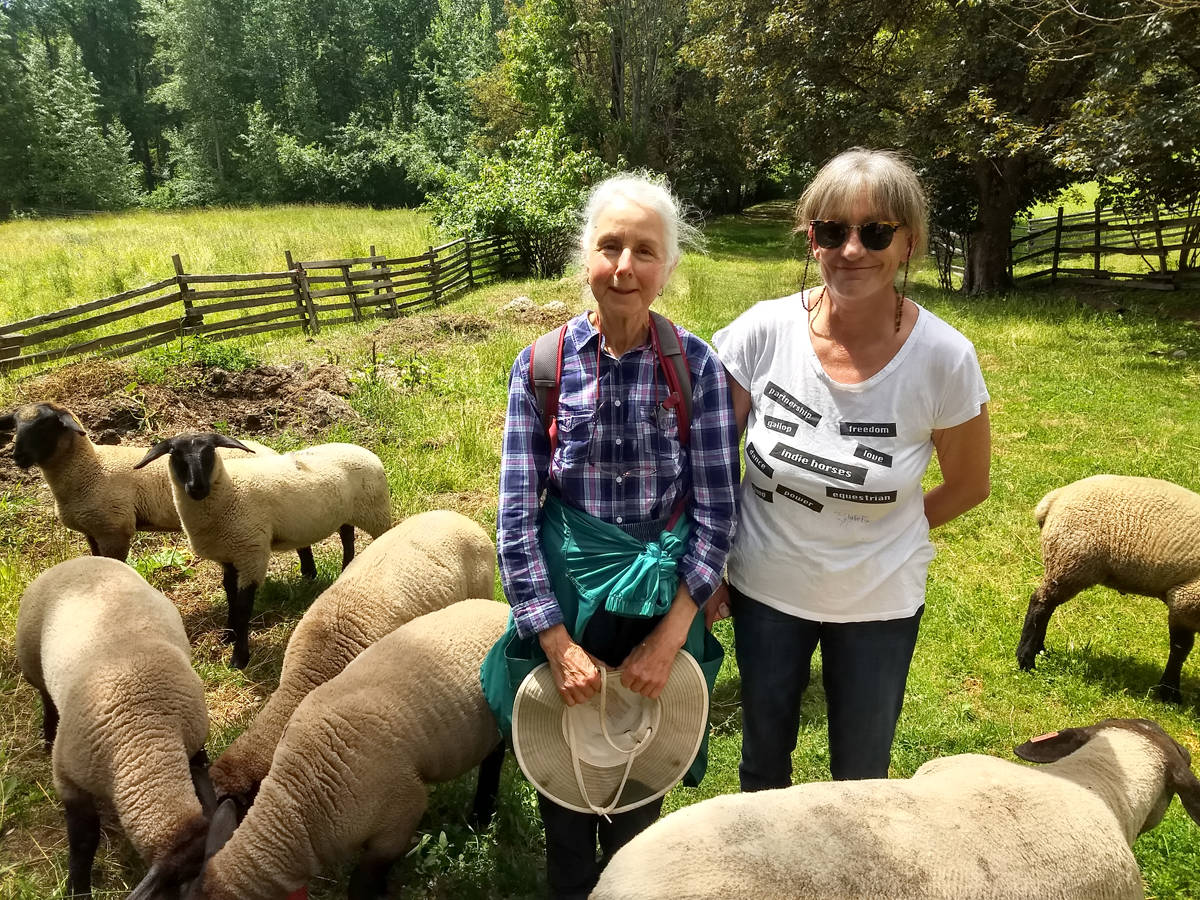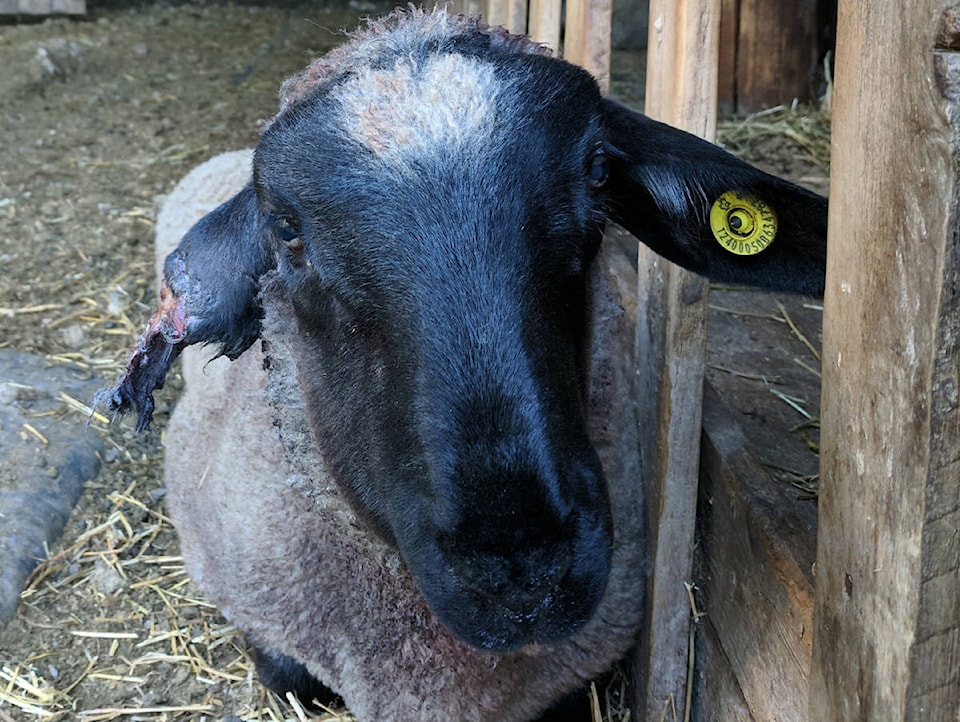It was a rainy Canada Day Monday, and Judy Kerby had to feed her goats.
“I decided not to bring the dogs with me — I won’t do that again,” the senior says.
Kerby brought a pail of feed out to the goat’s pen.
She didn’t think twice when her prize Nubian buck didn’t come around the corner to feed. She started fiddling with the fencing, then noticed something out of the corner of her eye.
“There was a bear there, on top of the buck, no further away from me than that,” she says, pointing to a post on the patio we’re sitting on. “It was such a shock.”
The goat was dead, in the middle of being eaten, starting from the hindquarters.
The bear finally backed off, but showed little concern, even as she set her dogs after it, Kerby recalls.
The behaviour of bears this year has Kerby and another Happy Valley farmer concerned. They say the bears around Rossland have changed — are unafraid and aggressive.
“It’s very unusual and uncharacteristic,” says Nancy Kaiser, Kerby’s neighbour down the hill.
Kaiser had her own encounter with a different bear and her livestock, just the week before Kerby.
“It was about 7:30 at night, and he had hold of the lamb by the ear,” Kaiser says. “It was just a young one — the lamb was almost as big as him.
“I came out and yelled, but he was not going to let go with just me there,” she says. “Until I got the dog. Then he let go.
“But he just sauntered away, not even afraid.
“I don’t have the answer, but I just know something is different, very different,” says Kaiser. “It’s the first time I have seen a bear in daylight in 10 years.
Both women say bears, coyotes and other predators are a fact of life in Happy Valley — a rural neighbourhood on the edge of Rossland. Their farms have been there for decades, and between them the women have worked the land, raising chickens, sheep and cows for nearly 70 years combined.
But they say in the last 10 years, and the last five especially, things have changed.
“They’re not the same kind of bears that we had up to about 10 years ago,” says Kerby. “Now we have desensitized and habituated bears.”
Kerby says they knew the previous owners of their property, who never told them stories about bear problems.
Town a ‘bear haven’
The women say the change in bears has paralleled a change in attitude in Rossland itself.
“The town has become a bear haven really, because of the young people,” says Kerby. “They’re dangerous, but people think they’re wonderful.”
“The city people are moving here and the bears are in the yard because of garbage or fruit or whatever,” adds Kaiser. “They’re igniting bear bombs, and the bears are hardly scared anymore, and all they do is run into the neighbour’s yard. They are training us to be careless around them because we are so oblivious.”
And they say Bear Aware programs aren’t dealing with the issue.
“Their approach is to eliminate all food sources, which you will never do in a town,” says Kerby. “They’re comfortable and safe in town, and they’re just going to look for another food source.”
Both women would like to see more public education, and culling bears that have lost their fear.
“They [Bear Aware] don’t want to see bears killed. But it’s not like they’re an endangered species,” says Kerby. “It’s all about the bears. It’s unbalanced. It’s just so biased towards the bear and I don’t see it solving the problem.”
Bear Aware responds
Desiree Profili, the community coordinator for Rossland/Trail WildsafeBC, says she doesn’t think bear behaviour is changing. She says they have always sought out easy-to-access, high caloric food out of instinct.
“What is changing is access to non-natural food sources and new cubs being born in years when natural food sources would have limited the population increase,” she says. “This increases means more bears and easy access to human-based food sources is an attractant for young bears whose natural food sources are being picked or replaced with yards. These sows then have cubs which they train to find the same human-based food sources they were drawn to.”
And interactions with humans that don’t result in problems for the bears is becoming more common, she says.
“[F]or example, the small sow and her cub near the Redstone development — every day they are around humans — with no consequences — no harassing noise, no shock from electric fencing to say ‘hey, this garden or hen house or garbage is not a good food source.’ People are stopping, taking pictures, getting as close as possible and eventually with enough time or lack of understanding that as cute as they are — she is a mother bear who will protect her cub if she feels threatened or is disturbed while eating.”
There are more bear encounters in the backcountry around Rossland, says Profili, as more people use the area for recreation, and there is some cause to worrry in town.
“Bears on Main Street at mid-day or on the playground at 2 p.m. like last summer are not natural and are definitely concerning,” she says. “Controlling attractants — everything from fruit to bird feeders to garbage, compost, and even livestock is the best place to start to help with this issue, as well as educating children and adults alike as to what to do when they encounter wildlife in an urban setting.”
Profili says COs have tried trapping bears as a result of the farmers’ complaints, but she notes fencing is still their best option.
“When it comes to livestock, electric fencing is the gold standard for eliminating the attractant. Horse fencing and bear/predator fencing are very different,” she says. “There are great resources in our area for helping set up proper fencing.”
‘Someone will be killed’
The women in Happy Valley say their opinion won’t be popular in town, or even in their neighbourhood. But raising livestock — and losing it — has made them practical-minded about what has to be done.
“Now, nuisance bears are allowed to keep going,” says Kaiser. “They have babies and their babies are fearless. They don’t kill these bears until they become dangerous.”
“They should kill these first ones,”says Kerby. “You don’t wait till you have a town full. But if they started now, people would have a fit.”
But they fear the consequences of not tackling the problem.
“Someone will be killed, and it’ll be a child,” says Kerby. “They’re opportunists, they’re not going to go for anything big.”

